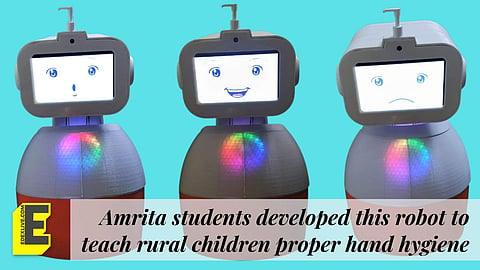

In the past couple of years, we've learnt that washing hands properly is not merely good manners but essential for survival. The importance of maintaining proper hand hygiene in the wake of COVID-19 cannot be stressed enough. However, it might be difficult to make children understand its importance. This robot by MTech students of Amrita Vishwa Vidyapeetham can help with that. Called HaKsh-E, the social robot not only monitors one's handwashing technique but also provides gentle nudges to children so that they wash their hands properly.
HaKsh-E has been designed and developed by a team of Ammachi Labs interns — Sreejith Sasidharan, Devasena Pasupuleti, Anand M Das and Pranav Prabha. However, this is not the first handwashing robot from these interns. "The previous robot, Pepe, was developed in 2018. However, it needed human intervention as someone had to continuously monitor the robot and also interact with the children. Through HaKsh-E, we aim to automate that process," says Sreejith, who recently graduated with an MTech in Robotics and Automation. Sreejith and his team began working on HaKsh-E in September 2020.
So, how are they automating it? By combining technologies like Artificial Intelligence, Machine Learning and Deep Learning techniques, of course. "The new robot has been integrated with handwashing steps as recommended by the World Health Organization. The robot will be present at the handwashing area, with a camera located on the top and on the side. It can identify the hand gestures and if the child misses a step in the six-step process, the robot will inform them about it," says Sreejith, explaining the process. The students are being guided by their professor Gayathri Manikutty.
Speaking about how they went about designing the robot, Devasena says, "We conducted a primary survey among school children in rural areas of Telangana, Kerala, Andhra Pradesh and even among school children in New Delhi." She states that these children's inputs helped them design the robot, which looks like a soap dispenser. "The interaction with the children also helped us understand, develop and integrate the interactive Artificial Intelligence component within the robot," adds Devasena, a final-year MTech student in Robotics and Automation.
Although the initial prototype has been built, the team is still working on the interactive model and also introducing empathy to the robot's system. But they didn't have to look for much to decide the name. "The name is inspired by a combination of two Sanskrit words. 'Hastakah' (meaning 'hand') and 'Kshalanam' (meaning 'cleaning'). Since the robot is meant to induce hand hygiene in Indian children, especially those in rural India, we decided to go with a traditional Sanskrit name," says Devasena. The team plans to install the robot in public spaces like schools, colleges and also in offices at a later stage.
